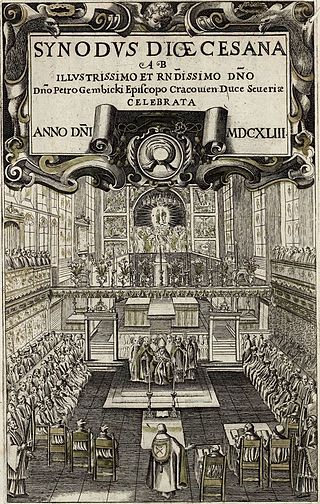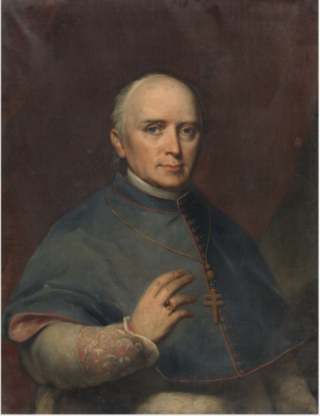
A synod is a council of a Christian denomination, usually convened to decide an issue of doctrine, administration or application. The word synod comes from the Ancient Greek σύνοδος 'assembly, meeting'; the term is analogous with the Latin word concilium'council'. Originally, synods were meetings of bishops, and the word is still used in that sense in Catholicism, Oriental Orthodoxy and Eastern Orthodoxy. In modern usage, the word often refers to the governing body of a particular church, whether its members are meeting or not. It is also sometimes used to refer to a church that is governed by a synod.

In the United Kingdom, a scheduled monument is a nationally important archaeological site or historic building, given protection against unauthorised change.

In the United Kingdom, a listed building is a structure of particular architectural and/or historic interest deserving of special protection. Such buildings are placed on one of the four statutory lists maintained by Historic England in England, Historic Environment Scotland in Scotland, Cadw in Wales, and the Northern Ireland Environment Agency in Northern Ireland. The term has also been used in the Republic of Ireland, where buildings are protected under the Planning and Development Act 2000, although the statutory term in Ireland is "protected structure".

A consistory court is a type of ecclesiastical court, especially within the Church of England where they were originally established pursuant to a charter of King William the Conqueror, and still exist today, although since about the middle of the 19th century consistory courts have lost much of their subject-matter jurisdiction. Each diocese in the Church of England has a consistory court.

The Society for the Protection of Ancient Buildings (SPAB) is an amenity society founded by William Morris, Philip Webb, and others in 1877 to oppose the destructive 'restoration' of ancient buildings occurring in Victorian England. "Ancient" is used here in the wider sense rather than the more usual modern sense of "pre-medieval."

Historic preservation (US), built heritage preservation or built heritage conservation (UK) is an endeavor that seeks to preserve, conserve and protect buildings, objects, landscapes or other artifacts of historical significance. It is a philosophical concept that became popular in the twentieth century, which maintains that cities as products of centuries' development should be obligated to protect their patrimonial legacy. The term refers specifically to the preservation of the built environment, and not to preservation of, for example, primeval forests or wilderness.

The Ancient Monuments and Archaeological Areas Act 1979 or AMAAA was a law passed by the UK government, the latest in a series of Ancient Monument Acts legislating to protect the archaeological heritage of England and Wales, and Scotland. Northern Ireland has its own legislation.

The Public Worship Regulation Act 1874 was an Act of Parliament of the United Kingdom, introduced as a Private Member's Bill by Archbishop of Canterbury Archibald Campbell Tait, to limit what he perceived as the growing ritualism of Anglo-Catholicism and the Oxford Movement within the Church of England. The bill was strongly endorsed by Prime Minister Benjamin Disraeli, and vigorously opposed by Liberal party leader William Ewart Gladstone. Queen Victoria strongly supported it. The law was seldom enforced, but at least five clergymen were imprisoned by judges for contempt of court, which greatly embarrassed the Church of England archbishops who had vigorously promoted it.
The General Synod is the tricameral deliberative and legislative organ of the Church of England. The synod was instituted in 1970, replacing the Church Assembly, and is the culmination of a process of rediscovering self-government for the Church of England that had started in the 1850s.
In the Catholic Church, an exemption is the full or partial release of an ecclesiastical person, corporation, or institution from the authority of the ecclesiastical superior next higher in rank. For example, the Roman Catholic Archdiocese of Strasbourg, and the Latin Patriarchate of Jerusalem are exempt, being directly subject to the Holy See.

Daniel Murray was a Roman Catholic Archbishop of Dublin.

The Church of England Assembly (Powers) Act 1919 is an Act of the Parliament of the United Kingdom that enables the Church of England to submit primary legislation called Measures, for passage by Parliament. Measures have the same force and effect as Acts of Parliament. The power to pass measures was originally granted to the Church Assembly, which was replaced by the General Synod of the Church of England in 1970 by the Synodical Government Measure 1969.
The canon law of the Roman Catholic Church recognizes various meanings of the term emancipation.

The destruction of country houses in 20th-century Britain was the result of a change in social conditions: many country houses of varying architectural merit were demolished by their owners. Collectively termed by several authors "the lost houses", the destruction of these now often-forgotten houses has been described as a cultural tragedy.

The Ancient Monuments Act 1900 was an Act of the Parliament of the United Kingdom that aimed to improve the protection afforded to ancient monuments in Great Britain.

The Ancient Monuments Protection Act 1910 was an Act of the Parliament of the United Kingdom that aimed to improve the protection afforded to ancient monuments in Britain.

The Ancient Monuments Act 1931 was an Act of the Parliament of the United Kingdom that aimed to improve the protection afforded to ancient monuments in Britain.

Robertsbridge United Reformed Church is a former United Reformed Church place of worship in Robertsbridge, a village in the district of Rother in the English county of East Sussex. Built for Congregational worshippers in 1881 following their secession from a long-established Wesleyan Methodist chapel, it was the third Nonconformist place of worship in the village, whose nearest parish church was in the neighbouring settlement of Salehurst. Like the former Strict Baptist and Methodist chapels in the village, which have both closed, it no longer serves Robertsbridge as a place of worship. Local architect Thomas Elworthy's distinctive design—a "rich" and highly decorated blend of several styles—has divided opinion amongst architectural historians. English Heritage has listed the church at Grade II for its architectural and historical importance.
Sir Charles Reed Peers was an English architect, archaeologist and preservationist. After a 10-year gap following the death of Lieutenant-General Augustus Pitt Rivers in 1900, Peers became England's second Inspector of Ancient Monuments from 1910 and was then the first Chief Inspector of Ancient Monuments from 1913 to 1933.
In English law, restitution of conjugal rights was an action in the ecclesiastical courts and later in the Court for Divorce and Matrimonial Causes. It was one of the actions relating to marriage, over which the ecclesiastical courts formerly had jurisdiction.












